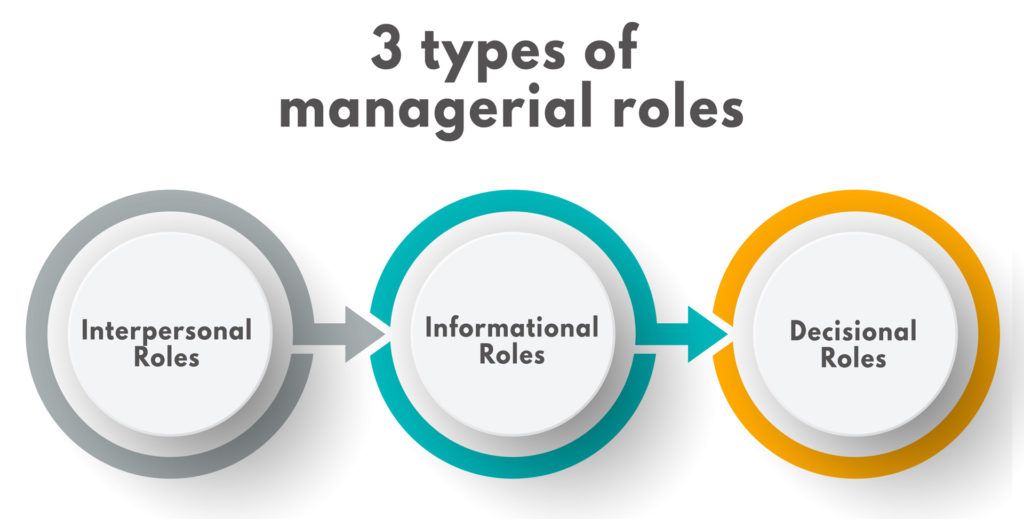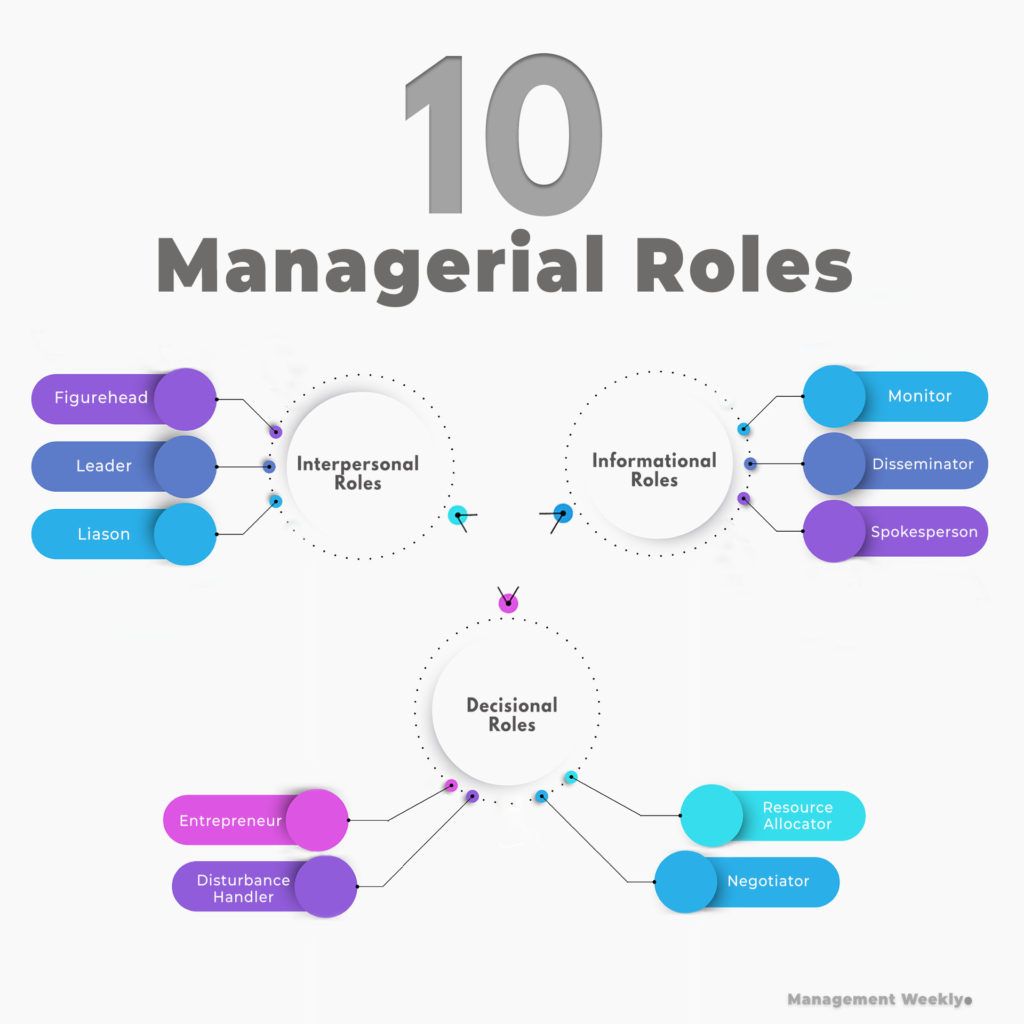Managers have an elemental role in the development of our modern societies. But what exactly do they do? Mintzberg‘s management roles provides an answer!
Contents
What does a manager do?
We know more about the motives, habits, and most intimate arcana of the primitive people of New Guinea or elsewhere than we do of the denizens of the executive suites in Unilever House.
Roy Lewis and Rosemary Stewart (1958:17)
Henry Mintzberg’s pursued this simple question for over a decade. It lead him to the publication of several books. Further, he talks about the managerial roles in his book “The nature of managerial work.” According to him, all the managers have some common patterns. Mintzberg also published another book: “Mintzberg on Management: Inside our Strange World of Organizations.”
The 3 types of managerial roles

Broadly speaking, there are three types of managerial roles:
- Interpersonal Roles
- Informational Roles
- Decisional Roles
Interpersonal Roles
The Interpersonal Roles of a manager are about the social aspect of a manager. Firstly, the job of a manager is to be the head of the team. This entrusts responsibilities to her/him. Consequently, the manager has to build trust in teams. Secondly, the manager is also supposed to lead the team from within. Thirdly, he is also supposed to communicate with the external stakeholders. The subordinate team members would have other roles that would prevent them from executing this role. They would also have a very narrow perspective of their work. A manager is expected to have a broader view. Therefore, the manager has the responsibility of the interpersonal aspects of the team.
Informational Roles
The second set of roles of a manager is related to the interchange of information. The manager is espoused with the responsibility of managing the uncertainty. Certainty comes with the right information. It should be in the right place and at the right time. Firstly, the manager is supposed to monitor the information. They are the custodian of critical information. They manage documents and insights about the functioning of their team. Secondly, they provide information to other team members as well as their reporting managers. Finally, they also act as spokespersons to communicate information outside their team.
Decisional Roles
The manager is also a decision-maker. This is the third type of role. They are expected to render their service in running the organization. Firstly, they are expected to assess risks and rewards for each decision. Then they have to decide accordingly. Secondly, they are also expected to handle any disruptions to the business. Thirdly, they have to decide where the firm spends its efforts. Finally, the managers also have to ensure that the stakeholders are on the same page. The objectives of the firm must be met through the efforts and interests of individuals. A manager negotiates this common ground. Above all, the manager has to ensure they abide by the models of ethics.
Henry Mintzberg’s Management Roles
Mintzberg pontified the types of management roles. He said that there are 10 major types of roles:

Interpersonal Roles
1. Figurehead
The figurehead represents the head of a team. As a figurehead, you ‘head’ the team. Also, the figurehead is the representative of activities and ceremonies of the team.
2. Leader
On one hand, the managers are the figurehead of the teams. On the other hand, they have a bigger role to play as the leader of the team. As a leader, you are expected to inspire the team. You communicate ideas between stakeholders. You also provide support and direction to the subordinates.
3. Liaison
The word Liason comes from the French word lier which means ‘to bind.’ It signifies a binder element in cooking. Similarly, the liaison for the team binds the team to the outside world.
Informational Roles
4. Monitor
The monitor of a team facilitates the operations. Also, they collect and process information. Therefore they help identify the threats and opportunities. Think of the role of a real-life case of SWOT analysis.
5. Disseminator
One of the roles of a manager is to pass on the information between organizational layers. Additionally, the manager also has to assign work and responsibilities to others.
6. Spokesperson
We have talked about the role of a disseminator. Meanwhile, managers also need to communicate outside the organization. This comes under the role of a spokesperson.
Decisional Roles
7. Entrepreneur
Managers take on this important responsibility. An entrepreneur takes risks in return for something less certain. Inside the organization, managers are expected to be entrepreneurial.
8. Disturbance Handler
Everything does not always works as expected. Sometimes, there are issues, problems, delays, and unexpected errors in the systems. Also, a disturbance handler helps in overcoming these challenges. Additionally, they foresee and mitigate the negative impact of disturbances.
9. Resource Allocator
The entity in an organization that helps in generating business output is a resource. In other words, organizations are seen as an assemblage of interconnected resources. Managers organize these resources into working units.
10. Negotiator
Finally, the role of a negotiator is also Mintzberg’s management role. This is a charismatic role. Negotiations are done with internal as well as internal stakeholders. Certainly, the managers ensure a favorable outcome in these negotiations.
Examples of Mintzberg’s Management Roles

| Mintzberg’s Management Role | Example of work |
|---|---|
| Figurehead | Approvals of budget, plans, etc |
| Leader | Inspiring your team to meet goals |
| Liaison | Co-ordinate the Cross-Functional Teams |
| Monitor | Evaluate the daily KPI dashboard |
| Disseminator | Inform the team about a problem with KPI and assign roles |
| Spokesperson | Communicate the KPI issues with higher managers. |
| Entrepreneur | Initiate and execute digital transformation |
| Disturbance Handler | Resolve a discord between two team-members. |
| Resource Allocator | Cut budget from a non performing asset |
| Negotiator | Talk with the clients to ask for extention of project deadline |
1. Figurehead
2.Leader
3. Liason
4. Monitor
5. Disseminator
6. Spokesperson
7. Entrepreneur
8. Disturbance Handler
9. Resource Allocator
10. Negotiator

4 thoughts on “Mintzberg’s Management Roles”